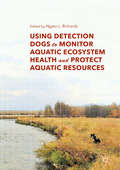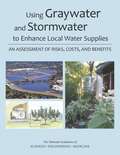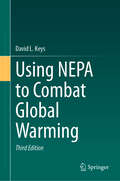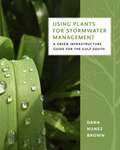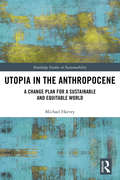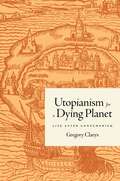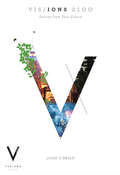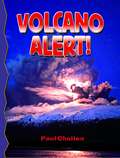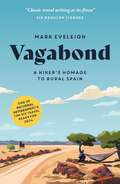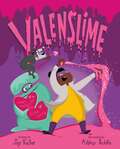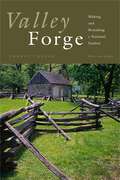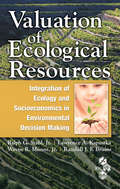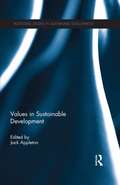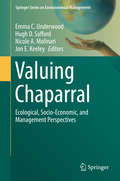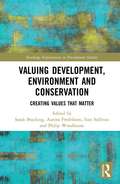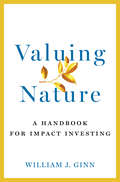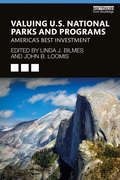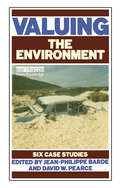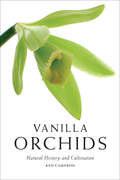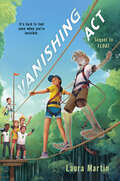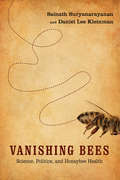- Table View
- List View
Using Detection Dogs to Monitor Aquatic Ecosystem Health and Protect Aquatic Resources
by Ngaio L. RichardsThis book is about the varied range of emerging applications using specially trained detection dogs to monitor and protect aquatic ecosystems, animals, plants and related resources. Featuring contributions from those at the forefront of converging disciplines ranging from canine training, ecological and biological monitoring, water resource management, law enforcement, and eco-toxicology, it addresses everyone already immersed in these or related fields, and anyone seeking to gain a broader understanding of them. Chapters cover several common themes including monitoring presence/absence through biological and ecological surveys; maintaining and evaluating water quality; law enforcement and anti-poaching initiatives; public education, awareness and compliance; standards and best practices; optimal uses of dogs in relation to and in conjunction with other available tools and pragmatic considerations for selecting and working with dogs and handlers. The aim of the book is to stimulate new ideas, promote the sharing and dissemination of information and findings - and, ideally, to catalyze new and innovative partnerships, to strengthen the preservation and conservation of our aquatic heritage.
Using Energy Crops for Biofuels or Food: The Choice (Green Energy and Technology)
by Annoula Paschalidou Michael Tsatiris Kyriaki Kitikidou Christina PapadopoulouThis book performs a SWOT (strengths, weaknesses, opportunities and threats) analysis to examine the current food crisis and how it relates to the use of crops for energy. It analyses how energy crops may help solve humankind’s environmental changes and summarises the economic and practical changes of cultivating and utilising energy crops. Two of humanity’s greatest challenges are the need for more food production as well as growing demands for energy. Biofuel cultivation has been identified as a solution to growing energy use, and biomass power plants offer a rare renewable energy source that requires only basic technology.In this context, a dilemma arises concerning whether energy crops should be used for energy or to help remedy the food crisis. SWOT analysis allows us to organise and weigh different pros and cons against each other in terms of economics, job creation, environmental impacts, the climate change agenda, and European Union (EU) directives that promote biofuels over fossil fuels. By pursuing this approach, the book helps researchers and decision-makers cut through the many competing arguments in connection with this complex subject.
Using Graywater and Stormwater to Enhance Local Water Supplies: An Assessment of Risks, Costs, and Benefits
by Engineering Medicine National Academies of SciencesChronic and episodic water shortages are becoming common in many regions of the United States, and population growth in water-scarce regions further compounds the challenges. Increasingly, alternative water sources such as graywater-untreated wastewater that does not include water from the toilet but generally includes water from bathroom sinks, showers, bathtubs, clothes washers, and laundry sinks- and stormwater-water from rainfall or snow that can be measured downstream in a pipe, culvert, or stream shortly after the precipitation event-are being viewed as resources to supplement scarce water supplies rather than as waste to be discharged as rapidly as possible. Graywater and stormwater can serve a range of non-potable uses, including irrigation, toilet flushing, washing, and cooling, although treatment may be needed. Stormwater may also be used to recharge groundwater, which may ultimately be tapped for potable use. In addition to providing additional sources of local water supply, harvesting stormwater has many potential benefits, including energy savings, pollution prevention, and reducing the impacts of urban development on urban streams. Similarly, the reuse of graywater can enhance water supply reliability and extend the capacity of existing wastewater systems in growing cities. Despite the benefits of using local alternative water sources to address water demands, many questions remain that have limited the broader application of graywater and stormwater capture and use. In particular, limited information is available on the costs, benefits, and risks of these projects, and beyond the simplest applications many state and local public health agencies have not developed regulatory frameworks for full use of these local water resources. To address these issues, Using Graywater and Stormwater to Enhance Local Water Supplies analyzes the risks, costs, and benefits on various uses of graywater and stormwater. This report examines technical, economic, regulatory, and social issues associated with graywater and stormwater capture for a range of uses, including non-potable urban uses, irrigation, and groundwater recharge. Using Graywater and Stormwater to Enhance Local Water Supplies considers the quality and suitability of water for reuse, treatment and storage technologies, and human health and environmental risks of water reuse. The findings and recommendations of this report will be valuable for water managers, citizens of states under a current drought, and local and state health and environmental agencies.
Using NEPA to Combat Global Warming
by David L. KeysThis book will help policy makers, university students, and the general public understand how the National Environmental Policy Act (NEPA) is intended to work, and how it can be used to reduce greenhouse gas (GHG) emissions in order to combat global warming. Unlike all other books on NEPA, this book focuses on the global warming problem in terms of thermodynamics and entropy. It explains how NEPA can help combat global warming by operationalizing the “energy requirements and conservation potential” analysis requirement in the Council on Environmental Quality (CEQ) regulations, 40 CFR 1502.16 (a)(7), and it puts the past, present, and future of the NEPA statute, the CEQ regulations, and energy analysis requirements all in one easy to find, portable place. It will be an excellent resource for university students and teachers, policy analysts, and those members of the public that want to know all about the NEPA Process. As a third edition, the book contains new analysis on the amended NEPA statute (2023) and revised CEQ regulations (2024), CEQ’s January 9, 2023 interim guidance on how to incorporate GHG emissions into NEPA documents, the social costs of carbon, the long-term strategy of the United States to get to net-zero GHG by 2050, assessing climate risk in NEPA reviews, and the link between energy requirements analysis required by 40 CFR 1502.16 (a) (7) and reduced GHG emissions.
Using Plants for Stormwater Management: A Green Infrastructure Guide for the Gulf South
by Dana Nunez BrownThe subtropical climate of the Gulf South supports a varied abundance of flora, and this diversity is sustained by the ample amount of rainwater that characterizes the region. Managing rainwater in a planned environment and mitigating its effect on human habitation can test the skills of even the most seasoned landscape architect or designer. That challenge has never been more acute as increased human demand for natural resources compels professionals and home gardeners alike to seek out sustainable ecological solutions.In this guidebook, Dana Nunez Brown details ways to manage each drop of rainwater where it falls, using a cost-effective and environmentally sensitive approach. Under natural conditions, rainfall primarily percolates into the ground and flows as groundwater until it is absorbed by trees and other vegetation, after which it is evaporated into the atmosphere and the cycle starts anew. Brown identifies plants and techniques that leverage this natural process in order to filter, clean, and slow runoff, a practice known as Low Impact Development. Using Plants for Stormwater Management presents the native ecological communities and plant species of the Gulf South in easy-to-follow sections and diagrams. Information ranging from the productiveness of root structures and the compatibility of plants with local soils to the optimal elevation of specific vegetation and the average dimensions of foliage is represented by graphic icons for quick and easy identification. An accessible and essential resource, this book gives both novices and experts the know-how to harness rainfall and create beautiful, ecologically functioning landscapes.
Using Supercritical Water Oxidation to Treat Hydrolysate from VX Neutralization
by Committee on Review Evaluation of the Army Chemical Stockpile Disposal ProgramInformation on Using Supercritical Water Oxidation to Treat Hydrolysate from VX Neutralization
Utopia in the Anthropocene: A Change Plan for a Sustainable and Equitable World (Routledge Studies in Sustainability)
by Michael HarveyUtopia in the Anthropocene takes a cross-disciplinary approach to analyse our current world problems, identify the key resistance to change and take the reader step by step towards a more sustainable, equitable and rewarding world. It presents paradigm-shifting models of economics, political decision-making, business organization and leadership and community life. These are supported by psychological evidence, utopian literature and inspirational changes in history.The Anthropocene is in crisis, because human activity is changing almost everything about life on this planet at an unparalleled pace. Climate change, the environmental emergency, economic inequality, threats to democracy and peace and an onslaught of new technology: these planetwide risks can seem too big to comprehend, let alone manage. Our reckless pursuit of infinite economic growth on a finite planet could even take us towards a global dystopia. As an unprecedented frenzy of change grips the world, the case for utopia is stronger than ever. An effective change plan requires a bold, imaginative vision, practical goals and clarity around the psychological values necessary to bring about a transformation. This book will be of great interest to students and scholars of the environmental humanities, sustainability studies, ecological economics, organizational psychology, politics, utopian philosophy and literature – and all who long for a better world.
Utopian and Dystopian Explorations of Pandemics and Ecological Breakdown: Entangled Futurities (ISSN)
by Conrad Scott Rhiannon Firth Heather Alberro Nora Castle Emrah AtasoyThis edited collection, which is situated within the environmental humanities and environmental social sciences, brings together utopian and dystopian representations of pandemics from across literature, the arts, and social movements.Featuring analyses of literary works, TV and film, theater, politics, and activism, the chapters in this volume home in on critical topics such as posthumanism, multispecies futures, agency, political ecology, environmental justice, and Indigenous and settler-colonial environmental relations. The book asks: how do pandemics and ecological breakdown show us the ways that humans are deeply interconnected with the more-than-human world? And what might we learn from exploring those entanglements, both within creative works and in lived reality? Brazilian, Indian, Polish, and Dutch texts feature alongside classic literary works like Defoe’s A Journal of a Plague Year (1722) and Matheson’s I Am Legend (1954), as well as broader takes on movements like global youth climate activism. These investigations are united by their thematic interests in the future of human and nonhuman relationships in the shadow of climate emergency and increasing pandemic risk, as well as in the glimmers of utopian hope they exhibit for the creation of more just futures.This exploration of how pandemics illuminate the entangled materialities and shared vulnerabilities of all living things is an engaging and timely analysis that will appeal to environmentally minded researchers, academics, and students across various disciplines within the humanities and social sciences.
Utopianism for a Dying Planet: Life after Consumerism
by Gregory ClaeysHow the utopian tradition offers answers to today’s environmental crisesIn the face of Earth’s environmental breakdown, it is clear that technological innovation alone won’t save our planet. A more radical approach is required, one that involves profound changes in individual and collective behavior. Utopianism for a Dying Planet examines the ways the expansive history of utopian thought, from its origins in ancient Sparta and ideas of the Golden Age through to today's thinkers, can offer moral and imaginative guidance in the face of catastrophe. The utopian tradition, which has been critical of conspicuous consumption and luxurious indulgence, might light a path to a society that emphasizes equality, sociability, and sustainability.Gregory Claeys unfolds his argument through a wide-ranging consideration of utopian literature, social theory, and intentional communities. He defends a realist definition of utopia, focusing on ideas of sociability and belonging as central to utopian narratives. He surveys the development of these themes during the eighteenth and nineteenth centuries before examining twentieth- and twenty-first-century debates about alternatives to consumerism. Claeys contends that the current global warming limit of 1.5C (2.7F) will result in cataclysm if there is no further reduction in the cap. In response, he offers a radical Green New Deal program, which combines ideas from the theory of sociability with proposals to withdraw from fossil fuels and cease reliance on unsustainable commodities.An urgent and comprehensive search for antidotes to our planet’s destruction, Utopianism for a Dying Planet asks for a revival of utopian ideas, not as an escape from reality, but as a powerful means of changing it.
VISIONS 2100: Stories from Your Future
by John K. O'BrienStories from Your Future The complex issue of climate change is one that our race is struggling to address. The solutions are not beyond us in any way. Technological solutions exist, scientific knowledge is plentiful, the world can afford the transition but still significant action eludes us. Rational arguments for rapid action abound. We do not need any more of those. What is needed is a different way of communicating that inspires and attracts the widest possible group of humans towards wanting to travel on this same journey. As part of the VISIONS 2100 Project, this book tells of the power of Visions and invites the reader to create and share their own vision of a better world. Only by starting conversations of the future will we manage to build the world that we really want. The book balances worries about catastrophe with social and environmental improvements by referencing psychology, management thought, case studies and personal anecdotes. In also references the parallels between the world's journey and coping with the chronic illness of the author's wife. The book is framed around eighty short visions by some of the world's leading environmental thinkers including Mary Robinson, Christiana Figueres, Bill McKibben, Connie Hedegaard, Yvo de Boer and many others. Having a vision of a better world is likely to result in the world being better. 'Poverty is eradicated. Every child goes to school regardless of sex, race, religion or place of birth. Every woman enjoys equality with every man. Every household has access to energy. In 2100, the world is just.' Mary Robinson, Special Envoy on Climate Change, United Nations'Opportunity from 2100 forward is unimaginably vast and incredibly varied.' Christiana Figueres, Executive Secretary, UNFCCC 'Timing is everything, and it hurts to think we blew it.' Bill McKibben, 350.orgThe future is a beautiful, if challenging, partner. Your choice is whether you take the risk in having a first date or whether you are happy to accept a life of regret.www.visions2100.com
VOLCANO ALERT!
by Paul ChallenIntroduces volcanoes, discusses the different kinds of eruptions, and explains how to stay safe.
Vagabond: A Hiker's Homage to Rural Spain
by Mark EveleighRecounting Mark's incredible 1,225-km solo hike across the Iberian Peninsula, Vagabond is a homage to the disappearing lifestyle of the "vagabundo", as well as a celebration of rural Spain and its forgotten communities. It reminds us of the value of slowing down and connecting with others, and the beauty in taking life one step at a time.
Valenslime
by Joy KellerA young slime scientist's efforts to make a Valentine's Day friend for her slime explode in Valenslime, a clever and funny picture book companion to Joy Keller and Ashley Belote’s Frankenslime.Victoria Franken, slime scientist, loved her slime. And her slime loved her back. Ever since the dark and stormy night when Victoria Franken brought her slime to life, she and Goop have been great friends, but when Valentine's Day rolls around, Victoria comes to the horrifying realization that while she had many friends, Goop only had her. The only solution is for her to make him a new friend. But when Victoria gets bored waiting for lightning to strike twice, things get a bit out of control!
Valley Forge: Making and Remaking a National Symbol (Keystone Books)
by Lorett TreeseMore than four million people a year visit Valley Forge, one of America's most celebrated historic sites. Here, amid the rolling hills of southeastern Pennsylvania, visitors can pass through the house which served as Washington's Headquarters during the famous winter encampment of 1777–1778. Others picnic and jog in the huge park, complete with monuments, recreated log huts, and modern visitor center, all built to pay tribute to the Valley Forge story. In this lively book, Lorett Treese shows how Valley Forge evolved into the tourist mecca that it is today. In the process, she uses Valley Forge as a means for understanding how Americans view their own past. Treese explores the origins of popular images associated with Valley Forge, such as George Washington kneeling in the snow to seek divine assistance. She places Valley Forge in the context of the historic preservation movement as the site became Pennsylvania's first state park in 1893. She studies its "Era of Monuments" and the movement to "restore" Valley Forge in the spirit of Rockefeller's enormously popular colonial Williamsburg. Treese describes a Valley Forge fraught with controversy over the appropriate appearance and use of a place so revered. One such controversy, the "hot dog war," a brief but intense battle over concession stands, was spawned by Americans' changing perceptions of how a national park was to be used. The volatile Vietnam era prompted the state park commission to establish its "Subcommittee on Sex, Hippies, and Whiskey Swillers" to investigate park regulation infractions. Even today, people differ over exactly what happened at Valley Forge during the winter of 1777–1778. The modern visitor sees the remains of over a century of commemoration, competition, and contention. The result, Treese shows, is a historic site that may reveal more about succeeding history than about Washington's army. This book will give its readers a new way to look at Valley Forge—and all historic sites.
Valuation of Ecological Resources: Integration of Ecology and Socioeconomics in Environmental Decision Making
by Lawrence A. Kapustka Wayne R. Munns Jr. Randall J. Bruins Ralph G. Stahl Jr.Choosing the optimal management option requires environmental risk managers and decision makers to evaluate diverse, and not always congruent, needs and interests of multiple stakeholders. Understanding the trade-offs of different options as well as their legal, economic, scientific, and technological implications is critical to performing accurate
Values in Sustainable Development: Values In Sustainable Development (Routledge Studies in Sustainable Development)
by Jack AppletonTo enhance sustainable development research and practice the values of the researchers, project managers and participants must first be made explicit. Values in Sustainable Development introduces and compares worldviews and values from multiple countries and perspectives, providing a survey of empirical methods available to study environmental values as affected by sustainable development. The first part is methodological, looking at what values are, why they are important, and how to include values in sustainable development. The second part looks at how values differ across social contexts, religions and viewpoints demonstrating how various individuals may value nature from a variety of cultural, social, and religious points of view. The third and final part presents case studies ordered by scale from the individual and community levels through to the national, regional and international levels. These examples show how values can motivate, be incorporated into and be an integral part of the success of a project. This thought-provoking book gives researchers, students and practitioners in sustainable development a wealth of approaches to include values in their research.
Valuing Chaparral: Ecosystem Services And Resource Management (Springer Series On Environmental Management)
by Jon E. Keeley Emma C. Underwood Hugh D. Safford Nicole A. MolinariChaparral shrubland ecosystems are an iconic feature of the California landscape, and a highly biodiverse yet highly flammable backdrop to some of the fastest growing urban areas in the United States. Chaparral-type ecosystems are a common element of all of the world’s Mediterranean-type climate regions – of which California is one – yet there is little public appreciation of the intrinsic value and the ecosystem services that these landscapes provide. Valuing Chaparral is a compendium of contributions from experts in chaparral ecology and management, with a focus on the human relationship with chaparral ecosystems. Chapters cover a wide variety of subjects, ranging from biodiversity to ecosystem services like water provision, erosion control, carbon sequestration and recreation; from the history of human interactions with chaparral to current education and conservation efforts; and from chaparral restoration and management to scenarios of the future under changing climate, land use, and human population. Valuing Chaparral will be of interest to resource managers, the research community, policy makers, and the public who live and work in the chaparral dominated landscapes of California and other Mediterranean-type climate regions.
Valuing Development, Environment and Conservation: Creating Values that Matter (Routledge Explorations in Development Studies)
by Philip Woodhouse Sarah Bracking Sian Sullivan Aurora FredriksenPolicy-makers are increasingly trying to assign economic values to areas such as ecologies, the atmosphere, even human lives. These new values, assigned to areas previously considered outside of economic systems, often act to qualify, alter or replace former non-pecuniary values. Valuing Development, Environment and Conservation looks to explore the complex interdependencies, contradictions and trade-offs that can take place between economic values and the social, environmental, political and ethical systems that inform non-monetary valuation processes. Using rich empirical material, the book explores the processes of valuation, their components, calculative technologies, and outcomes in different social, ecological and conservation domains. The book gives reasons for why economic calculation tends to dominate in practice, but also presents new insights on how the disobedient materiality of things and the ingenuity of human and non-human agencies can combine and frustrate the dominant economic models within calculative processes. This book highlights the tension between, on the one hand, a dominant model that emphasises technical and ‘universalising’ criteria, and on the other hand, valuation practice in specific local contexts which is more likely to negotiate criteria that are plural, incommensurable and political. This book is perfect for researchers and students within development studies, environment, geography, politics, sociology and anthropology who are looking for new insights into how processes of valuation take place in the 21st century, and with what consequential outcomes.
Valuing Nature: A Handbook for Impact Investing
by William GinnAs the world faces unprecedented challenges such as climate change and biodiversity loss, the resources needed far outstrip the capabilities of nonprofits and even governments. Yet there are seeds of hope—and much of that hope comes from the efforts of the private sector. Impact investing is rapidly becoming an essential tool, alongside philanthropy and government funding, in tackling these major problems. Valuing Nature presents a new set of nature-based investment areas to help conservationists and investors work together.NatureVest founder William Ginn outlines the emerging private sector investing opportunities in natural assets such as green infrastructure, forests, soils, and fisheries. The first part of Valuing Nature examines the scope of nature-based impact investing while also presenting a practical overview of its limitations and the challenges facing the private sector. The second part of the book offers tools for investors and organizations to consider as they develop their own projects and tips on how nonprofits can successfully navigate this new space. Case studies from around the world demonstrate how we can use private capital to achieve more sustainable uses of our natural resources without the unintended consequences plaguing so many of our current efforts.Valuing Nature provides a roadmap for conservation professionals, nonprofit managers, and impact investors seeking to use market-based strategies to improve the management of natural systems.
Valuing U.S. National Parks and Programs: America’s Best Investment
by Linda J. Bilmes John B. LoomisThis book provides the first comprehensive economic valuation of U.S. National Parks (including monuments, seashores, lakeshores, recreation areas, and historic sites) and National Park Service (NPS) programs. The book develops a comprehensive framework to calculate the economic value of protected areas, with particular application to the U.S. National Park Service. The framework covers many benefits provided by NPS units and programs, including on-site visitation, carbon sequestration, and intellectual property such as in education curricula and filming of movies/ TV shows, with case studies of each included. Examples are drawn from studies in Santa Monica Mountains National Recreation Area, Golden Gate National Recreation Area, Everglades National Park, and Chesapeake Bay. The editors conclude with a chapter on innovative approaches for sustainable funding of the NPS in its second century. The framework serves as a blueprint of methodologies for conservationists, government agencies, land trusts, economists, and others to value public lands, historical sites, and related programs, such as education. The methodologies are relevant to local and state parks, wildlife refuges, and protected areas in developed and developing countries as well as to national parks around the world. Containing a series of unique case studies, this book will be of great interest to professionals and students in environmental economics, land management, and nature conservation, as well as the more general reader interested in National Parks.
Valuing the Environment: Six case studies (Environmental And Resource Economics Set Ser.)
by Jean-Philippe Barde David W. PearceThe 'Pearce Report', Blueprint for a Green Economy, puts the role which monetary evaluation of environmental costs and benefit. can play firmly into the public eye. This book goes further and looks at six countries where such evaluation techniques are applied and at the obstacles to their further use. The case studies, written by leading experts in each nation, show how these methods are being taken up in the UK, Norway and Italy and the ways in which they are already extensively in use in the USA, Germany and the Netherlands. The authors also describe the obstacles to their use, the lack of knowledge of environmental economics at government level; the competition from other government priorities; the failure of environmental groups to grasp the importance of financial evaluation to their cause. But, as this book makes clear, significant advances are being made, both in the implementation of these economic techniques and, above all, in striking and yet further developments in economic thinking.
Vanilla Orchids: Natural History and Cultivation
by Ken CameronWith more than 30,000 known species, orchids represent the largest family of plants. But only one genus has agricultural value—the Vanilla orchid. Leading orchid expert Ken Cameron covers the natural history of the world’s most popular flavor and fragrance and provides an introduction to the pollination, biology, structure, evolution, and diversity of Vanilla and related orchids. Vanilla Orchids also features methods for bean harvest, curing, and processing for enthusiasts who want to try it at home.
Vanishing Act (Float #2)
by Laura MartinFans of the Percy Jackson series and John David Anderson will love this sequel to the acclaimed novel Float, in which inconveniently invisible Hank must find a way to save Camp Outlier from a saboteur—and win the camp-wide challenge.Hank, Emerson, and their friends have returned to Camp Outlier for another summer of fun and shenanigans. Hank won’t let his RISK (Recurring Incident of the Strange Kind) factor of inconvenient invisibility stop him from having the best summer ever, even when it starts mysteriously turning people and objects around him invisible too. But between his invisibility and an internet celebrity joining their cabin, camp clown Hank is struggling to maintain his spotlight.Hank knows that if he can win the camp-wide challenge for his team, all eyes will be back on him (or, at least, on where everyone thinks the invisible kid is standing). But as the finish line approaches, it becomes clear that someone is trying to sabotage Camp Outlier—and Hank’s pursuit of camp-wide glory puts him in serious danger.Laura Martin’s books are the perfect blend of humor and heart, starring deeply relatable characters and highlighting classic middle grade themes in engaging, creative ways.
Vanishing America
by Miles A. PowellMiles Powell explores how early conservationists became convinced that the vitality of America's white races depended on preserving the wilderness. Some conservationists embraced scientific racism, eugenics, and restrictive immigration laws, but these activists also laid the groundwork for the many successes of the modern environmental movement.
Vanishing Bees: Science, Politics, and Honeybee Health
by Daniel Lee Kleinman Sainath SuryanarayananIn 2005, beekeepers in the United States began observing a mysterious and disturbing phenomenon: once-healthy colonies of bees were suddenly collapsing, leaving behind empty hives full of honey and pollen. Over the following decade, widespread honeybee deaths--some of which have come to be called Colony Collapse Disorder (CCD)--have continued to bedevil beekeepers and threaten the agricultural industries that rely on bees for pollination. Scientists continue to debate the causes of CCD, yet there is no clear consensus on how to best solve the problem. Vanishing Bees takes us inside the debates over widespread honeybee deaths, introducing the various groups with a stake in solving the mystery of CCD, including beekeepers, entomologists, growers, agrichemical companies, and government regulators. Drawing from extensive interviews and first-hand observations, Sainath Suryanarayanan and Daniel Lee Kleinman examine how members of each group have acquired, disseminated, and evaluated knowledge about CCD. In addition, they explore the often-contentious interactions among different groups, detailing how they assert authority, gain trust, and build alliances. As it explores the contours of the CCD crisis, Vanishing Bees considers an equally urgent question: what happens when farmers, scientists, beekeepers, corporations, and federal agencies approach the problem from different vantage points and cannot see eye-to-eye? The answer may have profound consequences for every person who wants to keep fresh food on the table.
